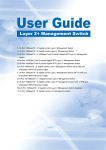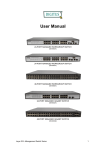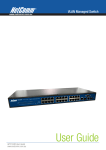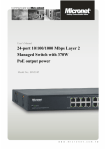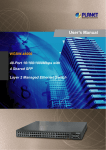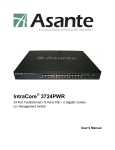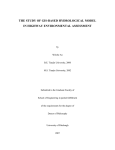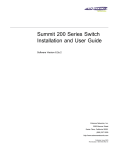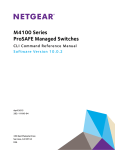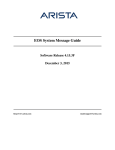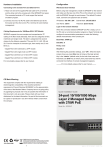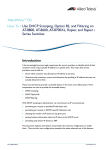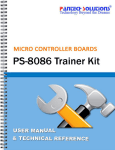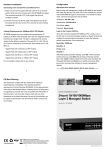Download User`s Manual - SysNet Center
Transcript
User’s Manual
24-port 10/100Mbps Layer 2
Managed Switch
Model No.: SP1658C
1
www.micronet.com.tw ; www.micronet.info
Table of Contents
1.
2.
3.
4.
5
Introduction ............................................................................................4
1.1 Package Contents ..............................................................................4
1.2 Feature ...............................................................................................4
1.3 Hardware Specification .......................................................................5
1.4 Environments Specification.................................................................7
1.5 Standard Conformance.......................................................................7
1.6 How to Use this Guide ........................................................................8
Installation ..............................................................................................9
2.1 Product Description Overview.............................................................9
2.2 Switch Overview .................................................................................9
2.3 LED Function ....................................................................................10
2.4 Reset Button .....................................................................................11
2.5 Installing the Switch ..........................................................................11
2.6 Rack- Mount Placement....................................................................13
Configuration .......................................................................................15
3.1 Web-based configuration ..................................................................16
3.2 Command Line Interface (by Console or Telnet) ..............................42
3.3 Privileged Mode commands..............................................................43
3.4 Global Config mode commands........................................................50
3.5 Interface Config mode commands ....................................................66
Specifications.......................................................................................70
4.1 Cable specifications ..........................................................................70
4.2 Technical specifications ....................................................................72
Warranty statement ............................................................................73
2
Notes and Cautions
A
NOTE indicates important information that helps you make
better use of your device.
A
of
NOTICE indicates either potential damage to hardware or loss
data and tells you how to avoid the problem.
A
CAUTION indicates a potential for property damage, personal
injury, or death.
3
1. Introduction
Micronet SP1658C 10/100Mbps Layer 2 Managed Switch offers high
performance and a full set of layer 2 networking management features at an
affordable cost, suitable for high performance workgroups and server
applications. With 10/100Mbps RJ-45 ports and shared mini-GBIC slots for
fiber optic connection, it delivers maximum throughput to high performance
users or provides a backbone to a growing business network.
1.1 Package Contents
Package contains the following:
SP1658C switch
RS-232 cable
Power cord or adapter
Rubber feet
Brackets
CD for user manual
and utilities
If any of the listed items is missing or damaged, please contact the place of
purchase for a replacement immediately.
1.2 Feature
Four groups (history, statistics, alarms, and events) of embedded remote
monitoring (RMON) agents for network monitoring and traffic analysis
■ Provides SNMP protocol(v1/v2c/v3) to monitor and control the switch by
using SNMP management applications such as HP Open View
■ Supports IGMP snooping to limit flooding of IP multicast traffic and filtering
for controlling the set of multicast groups to which hosts on a switch port can
belong
■ Supports 802.1d/1w/1s Spanning Tree Protocol for loop free installation.
■ Supports 802.1Q VLAN for assigning users to VLAN associated with
appropriate network resources, traffic patterns, and bandwidth. Up to 256
VLAN entries can be configured
■ Supports Management VLAN for administration to protect switch to be
attacked by client.
4
■ Supports IEEE 802.3ad Link Aggregation, up to 14 LAG groups, and 8 ports
for each LAG group
■ Built-in DHCP client to get IP address from DHCP server automatically
■ Supports SNTP to synchronize the precision time with Internet Time server.
■ Supports many-to-one, one-to-one Port Mirroring function.
■ Supports for IEEE 802.1p/DSCP CoS scheduling for classification and
preferred high-priority traffic.
■ Supports per port Ingress and Egress Rate Limiting.
■ Supports Dynamic Learning mode for Port Security function, up to 24 MAC
addresses can be learned for each port
■ Supports 802.1X port-based authentication, and build-in RADIUS client to
co-operate with the RADIUS servers.
■ Supports broadcast, multicast, and unknown unicast storm control
■ Supports Protected Port feature.
■ Supports SSL/SSH secure access.
■ Supports web-based interface for management
■ Supports CLI interface for local console or remote Telnet management
■ Supports TFTP, HTTP and X-modem protocol for firmware/configuration
upgrade or backup.
■ Supports TACACS+ login authentication.
■ Supports DSCP remarking
■ Supports DHCP Relay
■ Supports IGMP Proxy
■ Supports IGMP Querier
■ Supports LLDP
■ Supports IGMP Immediate Leave
■ Supports RSTP Root Guard
■ Supports DHCP/TFTP configuartion download
■ Supports Port Self-Loop Detection
■ Supports DHCP Snooping
■ Supports Dynamic ARP Inspection
■ Supports IP Source Guard
■ Supports Green Ethernet
■ Supports Auto Dos
1.3 Hardware Specification
■ Support 24 10/100Mbps copper ports with 2 shared mini-GBIC slots
5
■ User configurable 100FX or 1000Base-SX/LX mini-GBIC fiber module on
mini-GBIC ports
■ Supports half duplex and full duplex modes and auto-negotiation for all
10BASE-T/100BASE-TX/1000BASE-T ports
■ IEEE 802.3ab Auto MDI/MDI-X on all 100/1000 twisted-pair ports
■ Automatic polarity detection and correction on all RJ-45 ports for automatic
adjustment of wiring errors
■ Throughput up to 48 Gbps.
■ Provides IEEE802.3x Flow Control mechanism ensures zero packet loss,
which uses Back Pressure for half-duplex operation and Flow Control for full
duplex operation.
■ Supports 8K MAC address and Up to 4Mb packet buffer
■ Supports Store & Forward architecture and performs forwarding and filtering
■ Provides non-blocking switching performance
■ Supports Jumbo Frame up to 9KB
■ Provides a RS-232 port for system configuration.
■ Flexible TCAM-based Compact Field Process for packet classification and
filtering.
■ Low power consumption.
6
1.4 Environments Specification
Size (H x W x D)
Weight(Net/Gross)
H 44 x W 430 x D 250mm
2.4kg / 3.5kg (88.2 oz / 123.5 oz)
Power
30W
Operating Temp.
0 ℃ ~ 40 ℃(32 ℉ ~ 104 ℉)
Storage Temp.
-20 ℃ ~ 70 ℃(-4 ℉ ~ 158 ℉)
Operating Humidity
20% to 85% relative humidity, Non-Condensing
Storage Humidity
10% to 90% relative humidity, Non-Condensing
1.5 Standard Conformance
EMC Certification
FCC Class A, CE
7
1.6 How to Use this Guide
This user guide is structured as follows:
Chapter 2, Installation explains the functions of the switch and how to
physically install it.
Chapter 3, Configuration explains how to set up and modify the configuration
of the switch.
Chapter 4, Specifications contains information about the cables, and the
technical specifications of the switch.
Appendices include the Warranty Statement. Read them as
necessary.
8
2. Installation
This chapter describes the function of the management switch components
and shows how to install it on the desktop or shelf. Basic knowledge of
networking is assumed. Read this chapter completely before continuing.
2.1 Product Description Overview
Micronet SP1658C supports 802.1Q VLAN, QoS, 802.1d / 1w/ 1s Spanning
Tree Protocol, 802.1x, Port Security, Port Mirroring, IGMP Snooping, SNTP,
Storm Control, Rate Control, SNMP etc. features.
2.2 Switch Overview
Figure 2.2.1a
Front Panel
Figure 2.2.1b Rear Panel
Table 2.2.1c
Front
panel
Port
Function
1~24
This is where you connect the Cat. 5e or better ethernet
cable for 10/100Mbps ethernet connection
miniGBIC
Console
Real Panel
Port Function
Power
This is where you connect the SFP module for fiber
connection.
This is where you connect the RS-232 cable for CLI
management.
This is where you connect the AC power cord or DC
adapter.
9
2.3 LED Function
This section explains the definition of the Switch’s LEDs on the front panel.
POWER
LINK/ACT
▓(Green)
Green lights when connected to AC power
▓(Green)
Indicates a successful connection of a network. Otherwise, it
indicates the link is off or no-link detected of that port.
When the LED blinks, it indicates the port is activating and
transmitting data
10
2.4 Reset Button
There is a Reset button on the front panel, which has two functionalities:
a) To restore switch configuration to factory defaults
Press the Reset button for more than 10 seconds, switch configuration will
be restored to factory defaults and then reboots.
b) To reboot switch
Press the Reset button for less than 10 seconds, switch will reboot. Please
note, you will lose unsaved change when doing this.
2.5 Installing the Switch
This section describes how to install and make connection to the SP1658C
switch. The following diagrams shows the a typical network configuration,
(Figure 2.5.1)
Figure 2.5.1 Network Configuration for Layer 2 Management Switch
11
Read and perform the following procedures to install the switch,
Pre-Installation
Considerations
Gigabit
Considerations:
If you will use the switch for Gigabit
applications, keep in mind that the
maximum UTP cabling length of Category
5e cable is 328 feet (100 meters).
When choosing a location for the switch,
observe the following guidelines:
Keep enough ventilation space between
the switch and the surrounding objects.
Positioning the switch:
Keep cabling away from sources of
electrical noise, power lines, and
fluorescent lighting fixtures.
Do not stack free-standing switch more
than four units high.
Desktop or Shelf Mounting
To install the switch on a desktop or shelf, simply complete the following steps:
Step 1 Place the switch on a desktop or shelf near an AC power source.
Step 2 Keep enough ventilation space between the switch and the surrounding
objects.
Note: When choosing a location, keep in mind the environmental
restrictions discussed in Chapter 4, Specifications.
Step 3 Connect the switch to network devices.
A. Connect one end of a standard network cable to the RJ-45 ports on
the front of the switch.
B. Connect the other end of the cable to the network devices such as
printer servers, workstations or routers.
Note: It is recommended to use the UTP Category 5e network
cabling with RJ-45 tips for the network connection. For more
information, please see the Cable Specifications in Chapter 4,
Specifications.
Step 4 Supply power to the switch.
A. Connect one end of the power cable to the switch.
B. Connect the power cube end of the power cable to a standard wall
outlet.
12
2.6 Rack- Mount Placement
Before mounting the Switch, please read the following instructions carefully,
Elevated
Operating
Ambient
If installed in a closed or multi-unit rack assembly, the operating
ambient temperature of the rack environment may be greater
than room ambient. Therefore, consideration should be given to
installing the equipment in an environment compatible with the
maximum ambient temperature (Tma) specified by the
manufacturer.
Reduced Air
Flow
Installation of the equipment in a rack should be such that the
amount of air flow required for safe operation of the equipment is
not compromised.
Mechanical
Loading
Mounting of the equipment in the rack should be such that a
hazardous condition is not achieved due to uneven mechanical
loading.
Circuit
Overloading
Consideration should be given to the connection of the
equipment to the supply circuit and the effect that overloading of
the circuits might have on overcurrent protection and supply
wiring. Appropriate consideration of equipment nameplate
ratings should be used when addressing this concern.
Reliable
Earthing
Reliable earthing of rack-mounted equipment should be
maintained. Particular attention should be given to supply
connections other than direct connections to the branch circuit
(e.g. use of power strips)."
To mount the Switch in any standard-sized, 19-inch wide, 1U high rack, please
follow these instructions:
Place the Switch on a hard flat surface with the front panel facing you.
Attach a rack–mount bracket to one side of the Switch with the supplied
screws. Then attach the other bracket to the other side. (Figure 2.6.1)
Figure 2.6.1
13
Make sure the brackets are properly attached to the Switch.
Use the appropriate screws (not included) to securely attach the brackets to
your rack. (Figure 2.6.2)
Figure 2.6.2
14
3. Configuration
The configuration programs are supplied with the SP1658C Switch. Unlike the
unmanaged switch (dumb switch), the switch performs "management"
functions that make the switch operate more effectively. This Chapter will
describe the use of the switch Management Configuration program.
Preparing for configuration
SP1658C Management Switch offers a console CLI interface for switch
configuration and management. Users can use this interface to perform the
activities such as configuring DHCP, ARP, assigning IP address and
upgrading firmware etc.
There are four methods to manage your switch:
Local Console
Management
You can manage the switch locally by connecting the switch to a PC
or workstation with terminal emulation software using the serial port.
Remote Console
Management
You can manage the switch by having a remote host establish a
Telnet connection to the switch via an Ethernet or modem link.
SNMP Management
You can manage the switch across a LAN using a SNMP Network
Management Station with a graphical user interface. Note that to use
this management method, your network must use the IP protocol
and your switch must be configured on the Network with a proper IP
address. You may use any of the following method to manage the
switch.
Web-Browser
You can manage the switch through a web connection by connecting
to the switch’s IP address using your web browser.
This User Guide provides instructions on how to configure the switch using the
console interface. Read the following sections to start up:
Connecting a PC or Terminal
to the RS-232 Port
Terminal Emulation Setup
Program
Logging on to the switch
When you are ready to configure the Management
Function of the switch, make sure you have connected the
supplied RS-232 serial cable to the RS-232 port at the front
panel of your switch and your PC.
Run a terminal emulation program with the following
setting.
y
Emulation: VT-100 compatible
y
Baud per second: 38400
y
Data bits: 8
y
Parity: None
y
Stop bits: 1
y
Flow Control: None
Enter the factory default user name “admin” with no
password when logging on to the switch. The password is
set to be empty. If you can enter “?” on the command line
screen, it will display all items so that you can configure by
your requirements.
15
3.1 Web-based configuration
The Switch provides a Web-based interface for configuring and managing the
Switch. This interface allows you to access the switch using the Web browser
of your choice. This chapter describes how to use the switch’s Web browser
interface to configure and manage the switch.
Logging on the switch
To log on to the Switch:
Step 1. In your web browser, specify the IP address of the switch. Default IP
address is 192.168.1.254.
Step 2. Enter the factory default “admin “to login on the Switch with no
password. Refer to the figure 3-1.
Figure 3-1
16
3-1-1. System Information
3-1-2. Network Management
IP configuration is one of the most important configurations in the switch.
Without the proper setting, network manager will not be able to manage or
view the device. The switch supports both manual IP address setting and
automatic IP address setting via DHCP server. When IP address is changed,
you must reboot the switch to have the setting taken effect and use the new IP
to browse for web management and CLI management.
Function name:
Network Management
Function description:
Set IP address, subnet mask, default gateway and DNS for the switch.
3-1-3. Time Configuration
The switch provides manual and automatic ways to set the system time via
NTP. Manual setting is simple and you just input “Year”, “Month”, “Day”, “Hour”,
“Minute” and “Second” within the valid value range indicated in each item. If
you input an invalid value, for example, 61 in minute, the switch will clamp the
figure to 59.
Function name:
Time
Function description:
Set the system time by manual input or set it by syncing from Time servers.
The function also supports daylight saving for different area’s time adjustment.
17
3-2-1. Port Configuration
Port Configuration is applied to change the setting of each port. In this
configuration function, you can set/reset the following functions.
3-2-2. LACP property
The Port Trunking Configuration is used to configure the settings of Link
Aggregation. You can bundle more than one port with the same speed, full
duplex and the same MAC to be a single logical port, thus the logical port
aggregates the bandwidth of these ports. This means you can apply your
current Ethernet equipments to build the bandwidth aggregation. For
example, if there are three Fast Ethernet ports aggregated in a logical port,
then this logical port has bandwidth three times as high as a single Fast
Ethernet port has.
The switch supports two kinds of port trunking methods:
LACP:
Ports using Link Aggregation Control Protocol (according to IEEE 802.3ad
18
specification) as their trunking method can choose their unique LACP GroupID
(1~8) to form a logic “trunked port”. The benefit of using LACP is that a port
makes an agreement with its peer port before it becomes a ready member of a
“trunk group” (also called aggregator). LACP is safer than the other trunking
method - static trunk.
The switch LACP does not support the followings:
Link Aggregation across switches
Aggregation with non-IEEE 802.3 MAC link
Operating in half-duplex mode
Aggregate the ports with different data rates
Static Trunk:
Ports using Static Trunk as their trunk method can choose their unique Static
GroupID (also 1~8, this Static groupID can be the same with another LACP
groupID) to form a logic “trunked port”. The benefit of using Static Trunk
method is that a port can immediately become a member of a trunk group
without any handshaking with its peer port. This is also a disadvantage
because the peer ports of your static trunk group may not know that they
should be aggregate together to form a “logic trunked port”. Using Static Trunk
on both end of a link is strongly recommended. Please also note that low
speed links will stay in “not ready” state when using static trunk to aggregate
with high speed links.
As to system restrictions about the port aggregation function on the switch,
In the management point of view, the switch supports maximum 8 trunk groups
for LACP and additional 8 trunk groups for Static Trunk. But in the system
capability view, only 8 “real trunked” groups are supported. An LACP trunk
group with more than one ready member-ports is a “real trunked” group. An
LACP trunk group with only one or less than one ready member-ports is not a
“real trunked” group. Any Static trunk group is a “real trunked” group.
19
3-2-3. LAG Group
20
3-3-1. Create VLAN
The Create VLAN screen provides information and global parameters for
configuring and working with VLANs
.
3-3-2. VLAN Settings
3-3-3. VLAN Port
21
3-4-1. RSTP
The Rapid Spanning Tree Protocol (RSTP) provides rapid convergence of the
spanning tree by assigning port roles and by determining the active topology.
The RSTP builds upon the IEEE802.1D STP protocol to select the switch with
the highest switch priority as the root switch.
3-4-2. RSTP
3-4-3. MSTP
22
3-4-4. MSTP Port
3-4-5. MSTP Instance
3-4-6. MSTP Interface
23
3-5-1. Static Mulicast
Static multicast groups provides a way to add and delete multicast addresses
in the L2 address table.
3-5-2. Static Mulicast Table
3-5-3. IGMP
24
3-6-1. Port Security
Port Security provides two kinds of security modes, Static and Dynamic, to
limit user's access on all ports.
3-6-2. 802.1x
3-6-3. RADUS
3-6-4. Storm Control
3-6-5. Management IP List
25
26
3-7-1. QUEUE Settings
Scheduling Mode
Selectes Strict Priority, the packets in the higher queue will always be served
first until the queue is empty. Select Weighted Round Robin, the packets will
be served according to the queue weight.
Queue
Indicates priority queues. Queue 1 is the lowest priority queue, and Queue 4 is
the highest priority queue.
Weight
Indicates the weight (number of packets) to be served in the queue before
moving to serve next queue. A high priority queue should have a higher weight
than a low priority queue.
3-7-2. DSCP
3-7-3. 802.1P
3-7-4. Port based QoS
27
3-7-5. Rate Control
28
3-8-1. SNMP
Enable SNMP Functionalities
Enables or Disables SNMP function on this device.
Enable SNMP Notification
Enables or Disables SNMP notification function on this device.
Engine ID
Configures the Engine ID on this device.
3-8-2. Group Profile
3-8-3. User Profile
3-8-4. Community Profile
3-8-5. SNMP Trap Station
29
3-9-1. LLDP
Advertised Interval
The interval at which LLDP frames are transmitted on behalf of this LLDP
agent.
Hold value
A multiplier to Advertised interval. The result would be the TTL value for the
information advertised.
Transmit Delay
The delay between successive LLDP frame transmissions initiated by
value/status changes in the local system
Re-initialization delay
The minimum delay period before from the time a ports becomes disabled until
re-initialization.
Notification Interval
The interval at which notification are generated when remote MSAP
information changes.
Management Address Transmit Ports
Indicates the ports on which the management address will be transmitted.
Port Configuration
LLDP configuration for a port.
30
3-9-2. LLDP Statistics
3-9-3. LLDP Information
31
3-9-4. Remote Information
32
3-10-1. Admin
Admin Password
The screen allows user to change the password of the administrator.
Old Password
Enteres original password.
New Password
Enteres a desired password to replace the original one.
Confirm New Password
Enteres new password again for confirmation.
3-10-2. L2 Table
3-10-3. Static Address
33
3-10-4. Port Mirroring
3-10-5. Admin Timeout
3-10-6. Firmware Upgrade
3-10-7. Reboot
3-10-8. Save Configurations
34
3-10-9. Logs Settings
3-10-10. Log Server
3-10-11. Memort Logs
3-10-12. Flash Logs
35
3-10-13. Ping Function
3-10-14. Cable Diagnostic
3-10-15. DHCP Relay
3-10-16. DHCP Option 82
36
3-11-1. Statistics-802.1x Statistic
Port
Indicates the port number.
Octets Recieved
The number of octets received on this port during the session.
Octets Transmitted
The number of octets transmitted on this port during the session.
Session Time
The duration of the session in seconds.
Termination Cause
The reason for the session termination.T his parameter can take the following
values,
1) Supplicant Logoff (1)
2) Port Failure (2)
3) Supplicant Restart (3)
4) Reauthentication Failure (4)
5) AuthControlledPortControl set to ForceUnauthorized (5)
6) Port re-initialization (6)
7) Port Administratively Disabled (7)
8) Not Terminated Yet (999)
3-11-2. RMON Statistic
3-11-3. RMON Event
37
3-11-4. RMON Event log
3-11-5. RMON Alarm
38
3-11-6. RMON History
39
3-12-1. Help
40
3-13-1. Log out
41
3.2 Command Line Interface (by Console or Telnet)
Mode-based Command Hierarchy
The Command Line Interface (CLI) groups all the commands in appropriate
modes by the nature of the commands. Examples of the CLI command modes
are described below. Each of the command modes supports specific switch’s
commands.
The CLI Command Modes table captures the command modes, the prompts
visible in that mode and the exit method from that mode.
Table 1 CLI Command Modes
Command
Mode
Access Method
Prompt
Exit or Access
Previous Mode
User Mode
This is the first level of
access. Perform basic
tasks and list system
information.
COMMAND>
Enter Logout
command
Privileged
Mode
From the User Mode,
enter the enable
command.
Switch#
Global
Config Mode
From the Privileged Mode,
enter the configuration
command.
Switch (Config)#
Interface
Config Mode
From the Global Config
mode, enter the interface
<port#> command.
Switch (Interface
<port#>)#
To exit to the User
Mode, enter exit or
Logout.
To exit to the
Privileged Mode,
enter the exit
command.
To exit to the Global
Config mode, enter
exit.
The CLI is divided into various modes. The commands in one mode are not
available until the operator switches to that particular mode. The commands
available to the operator at any point in time depend upon the mode. By
entering a question mark (?) at the CLI prompt, it will display a list of the
available commands and descriptions of the commands.
The CLI provides the following modes:
User Mode
When the operator logs into the CLI, the User Mode is the initial mode. The
User Mode contains a limited set of commands. The command prompt shown
at this level is:
Command Prompt: COMMAND>
Privileged Mode
To have access to the full suite of commands, the operator must enter the
Privileged Mode. The Privileged Mode requires password authentication. From
Privileged Mode, the operator can issue any Exec command to enter the
Global Configuration mode. The command prompt shown at this level is:
Command Prompt: Switch#
42
Global Config Mode
This mode permits the operator to make modifications to the running
configuration. General setup commands are grouped in this mode. From the
Global Configuration mode, the operator can enter the Interface Configuration
mode. The command prompt at this level is:
Command Prompt: Switch(Config)#
From the Global Config mode, the operator may enter the following
configuration modes:
Interface Config Mode
Many features are enabled for a particular interface. The Interface commands
enable or modify the operation of an interface. In this mode, a physical port is
set up for a specific logical connection operation. The command prompt at this
level is:
Command Prompt: Switch(Interface <port#>)#
3.3 Privileged Mode commands
Commands
cable-diag
clear
Description
This command is used to proceed
cable diagnostic
Syntax
Format cable-diag port <port ID>
Mode Privileged Mode
e.g. Switch#cable-diag port 1
1) clear arl
This command is used to clear ARL table entries
1.1) clear arl dynamic
Format clear arl dynamic
This command is used to Clear
Mode Privileged Mode
dynamic arl table entries
Format clear arl static mac
1.2) clear arl static
This command is used to clear static
<mac-addr>
arl table entries
Mode Privileged Mode
2) clear config
Format clear config
This command is used to restore
Mode Privileged Mode
switch factory default configuration
3) clear counters
Format clear counters
This command is used to clear RMON
Mode Privileged Mode
statistics for entire switch
4) clear igmpsnooping
This command is used to restore
Format clear igmpsnooping
Mode Privileged Mode
igmpsnooping configuration to factory
default
5) clear static-mcast
Format clear static-mcast
This command is used to clear static
Mode Privileged Mode
multicast groups
6) clear pass
Format clear pass
This command is used to restore
administrator’s password to factory
Mode Privileged Mode
default
43
Commands
Description
Syntax
7) clear lacp
This command is used to restore LAG
and LACP configuration to factory
default
8) clear logs
This command is used to clear
memory/flash logs
9) clear vlan
This command is used to delete all
VLAN groups
Format clear logs
Mode Privileged Mode
configurat
ion
Enter into Global Configuration mode
Format configuration
Mode Privileged Mode
copy
This command is used to upload file from switch to host, or download file to
switch from host
1) copy nvram_config
Format copy nvram_config tftp
This command is used to backup
<A.B.C.D> file
switch configuration
e.g.
<filename>
Mode Privileged Mode
Switch#copy nvram_config tftp
192.168.1.100 file switch_configuration
Format copy system_image tftp
2) copy system_image
<A.B.C.D> <filename>
This command is used to backup
Mode Privileged Mode
switch runtime image
192.168.1.100 image_file
e.g. Switch#copy system_image tftp
3) copy tftp
This command is used to download
configuration or runtime image from
host to switch.
exit
help
logout
ping
reload
save
show
Format clear lacp
Mode Privileged Mode
Format clear vlan
Mode Privileged Mode
e.g.
Switch#copy tftp 192.168.1.100 file
switch_configuration nvram_config
Format copy tftp <A.B.C.D> file
<filename>
{nvram_config |
system_image}
Mode Privileged Mode
Switch#copy tftp 192.168.1.100 file
runtime_code system_image
This command is used to exit current
shell
This command displayss help
information
This command is used to exit current
shell
This command is used to proceed ping
destination host
This command is used to reboot
system
This command is used to save
configuration
Format exit
Mode Privileged Mode
Format help
Mode Privileged Mode
Format logout
Mode Privileged Mode
Format ping <A.B.C.D>
Mode Privileged Mode
Format reload
Mode Privileged Mode
Format save
Mode Privileged Mode
This command is used to show configured data
1.1) show qos cos
This command displays the cos
mapping
Format show qos cos
Mode Privileged Mode
44
Commands
Description
Syntax
1.2) show qos queue-settings
Format show qos queue-settings
This command displays the
Mode Privileged Mode
queue-settings mapping
1. 3) show qos advanced
This command displays qos advanced mode information
1.3.1) show qos advanced mode
Format show qos advanced mode
This command displays mode of qos
Mode Privileged Mode
1.3.2) show qos advanced dscp
This command displays qos dscp
mapping
1.3.3) show qos advanced
ip-precedence
This command displays qos ip
precedence mapping
Format show qos advanced dscp
Mode Privileged Mode
Format show qos advanced
ip-precedence
Mode Privileged Mode
1.4) show qos port-based
This command is used to displays class of service information
Format show qos port-based port
1.4.1) show qos port-based port
This command displays class of
<port-ID>
service information
Mode Privileged Mode
1.4.2) show qos port-based all
Format show qos port-based all
This command displays all switch
Mode Privileged Mode
interfaces’ cos settings
2) show dot1x
This command displays dot1x information
Format show dot1x config
2.1) show dot1x config
This command displays dot1x and port Mode Privileged Mode
configuration
2.2) show dot1x radius
Format show dot1x radius
This command displays radius
Mode Privileged Mode
configuration
Format show dot1x statistics
2.3) show dot1x statistics
This command displays dot1x statistics Mode Privileged Mode
3) show igmpsnooping
This command displays IGMP snooping information
Format show igmpsnooping
3.1) show igmpsnooping
dynamic_router_port
dynamic_router_port
This command displays dynamic router Mode Privileged Mode
ports information
Format show igmpsnooping
3.2) show igmpsnooping groups
This command is used to displays igmp groups
groups information
Mode Privileged Mode
3.3) show igmpsnooping info
Format show igmpsnooping info
This command displays IGMP
Mode Privileged Mode
Snooping configuration information
5) show lag
This command is used to displays link aggregation groups information
Format show lag lag-index
5.1) show lag lag-index
This command is used to specify an
<lag-id>
switch lag
Mode Privileged Mode
Format show lag all <lag-id>
5.2) show lag all
This command is used to displays all
Mode Privileged Mode
switch lags
45
Commands
Description
Syntax
6) show lldp
This command is use to displays lldp statistics
Format show lldp statistic
6.1) show lldp statistic
This command is used to displays lldp
Mode Privileged Mode
statistic
Format show lldp local
6.2) show lldp local
This command is used to displays local Mode Privileged Mode
information
6.3) show lldp msap
Format show lldp msap
This command is used to displays
Mode Privileged Mode
msap information
Format show lldp msap-entry
6.4) show lldp msap-entry
This command is used to displays
<1..26>
msap details information
Mode Privileged Mode
7) show logging
This command is used to displays trap records
Format show logging memory-log
7.1) show logging memory-log
This command displays memory log
Mode Privileged Mode
Format show logging flash-log
7.2) show logging flash-log
This command displays flash logs
Mode Privileged Mode
8) show monitor
Format show monitor
This command is used to displays port
Mode Privileged Mode
mirroring settings
Format show network
9) show network
This command is used to configuration Mode Privileged Mode
for inband connectivity
10) show port
This command is used to displays port mode and settings, displays port status
Format show port port-index
10.1) show port port-index
This command is used to specify an
<port-ID>
switch interface
Mode Privileged Mode
10.2) show port all
Format show port all
This command is used to displays all
Mode Privileged Mode
switch interface
11) show port-security
This command is used to displays port security settings
Format show port-security port
11.1) show port-security port
This command is used to specify an
<port-ID>
switch interface
Mode Privileged Mode
Format show port-security all
11.2) show port-security all
This command is used to displays all
Mode Privileged Mode
interfaces’ status
12) show rate-limit
This command is used to displays ingress and egress rate limit information
12.1) show rate-limit port
Format show rate-limit port
This command is used to specify an
<port-ID>
switch interface
Mode Privileged Mode
e.g. Switch#Show rate-limit port 1
Switch#Show rate-limit port g1
Format show rate-limit all
12.2) show rate-limit all
This command is used to displays all
Mode Privileged Mode
interfaces’ status
Format show running-config
13) show running-config
This command is used to displays
Mode Privileged Mode
switch running config
46
Commands
Description
Syntax
14) show snmp
This command is used to displays all snmp config
14.1) show snmp groups
Format show snmp groups
This command displays all snmp
Mode Privileged Mode
groups
Format show snmp users
14.2) show snmp users
This command displays all snmp users Mode Privileged Mode
14.3) show snmp communities
Format show snmp communities
This command displays all snmp
Mode Privileged Mode
communities
Format show snmp info
14.4) show snmp info
This command displays all snmp
Mode Privileged Mode
information.
15) show sntp
Format show sntp
This command is used to displays
Mode Privileged Mode
switch sntp information
16) show spanning-tree
This command displayss Spanning Tree information
16.1) show spanning-tree interface
This command displays RSTP ports information
16.1.1) show spanning-tree interface
Format show spanning-tree
port
interface port<port-ID>
This command specify an switch
Mode Privileged Mode
interface
16.1.2) show spanning-tree interface
Format show spanning-tree
all
interface all
This command displays all switch
Mode Privileged Mode
interface
16.2) show spanning-tree mst
This command displays MST information
16.2.1) show spanning-tree mst
Format show spanning-tree mst
detailed
detailed <0..4094>
This command displays a MST
Mode Privileged Mode
instance information
16.2.2) show spanning-tree mst
Format show spanning-tree mst
instance
instance <0..4094>
This command displays ports
Mode Privileged Mode
information on a MST instance
16.2.3) show spanning-tree mst
Format show spanning-tree mst
summary
summary
This command displays all MST
Mode Privileged Mode
instance information
Format show Spanning-tree
16.2.4) show spanning-tree status
This command is used to displays
status
spanning-tree status
Mode Privileged Mode
17) show storm-control
Format show storm-control
This command is used to displays
Mode Privileged Mode
storm-control information
18) show sysinfo
Format show sysinfo
This command is used to displays
system information including system up Mode Privileged Mode
time
19) show switch
This command is used to displays switch information
47
Commands
Description
Syntax
19.1) show switch admin-time
Format show switch admin-time
This command displays the age time of
Mode Privileged Mode
web and console
19.2) show switch age-time
Format show switch age-time
This command displays the age time of
Mode Privileged Mode
L2 table
19.3) show switch mac-table
This command is used to displays address resolution protocol cache
19.3.1)show switch mac-table all
Format show switch mac-table all
This command displays all element of
Mode Privileged Mode
the mac table
Format show switch mac-table
19.3.2)show switch mac-table vlan
This command displays all mac in a
vlan <vlan-id>
specify vlan
Mode Privileged Mode
Format show switch mac-table
19.3.3)show switch mac-table port
This command displays all mac in a
port <port-id>
specify port
Mode Privileged Mode
19.4) show switch mcast-table
Format show switch mcast-table
This command displays multicast
Mode Privileged Mode
address table
19.5) show switch mac
Format show switch mac
This command displays vlan and port
Mode Privileged Mode
info by the specific mac address
20) show trapflags
Format show trapflags
This command is used to displays the
Mode Privileged Mode
value of trap flags that apply to the
switch
21) show vlan
This command is used to displays vlan configuration
Format show vlan member
21.1)show vlan member
This command displays vlan
<1..4094>
configuration
Mode Privileged Mode
21.2)show vlan number
Format show vlan number
This command displays how many
Mode Privileged Mode
vlans has been created
22) show rmon
This command displays rmon information
22.1) show rmon event
Format show rmon event index
22.1.1) show rmon event Index
This command displays rmon event
<1..65535>
table.
Mode Privileged Mode
Format Show rmon event<CR>
22.1.2) show rmon event
Mode Privileged Mode
Format Show rmon event log
22.2) show rmon event log
event _index
This command displays rmon event
<1..65535>
log.
Mode Privileged Mode
22.3) show rmon alarm
22.31) show rmon alarm index
This command displays rmon Alarm
table.
22.3.2) show rmon alarm
show rmon alarm index
<1..65535>
Mode Privileged Mode
Format show rmon alarm<CR>
Mode Privileged Mode
Format
22.4) show rmon history
48
Commands
Description
Syntax
22.4.1)show rmon history index
This command displays enabled rmon
history.
show rmon history index
<1..65535>
Mode Privileged Mode
Format show rmon history <CR>
Mode Privileged Mode
Format Show rmon statistics
<port-index>
Mode Privileged Mode
22.4.2)show rmon history <CR>
Format
22.5) show rmon statistics
This command displayss port summary
statistics.
23 )show poe
This command is used to displays poe mode and settings,displays poe port
status
Format show poe port-index
23.1) show poe port-index
This command is used to specify an
<port-ID>
switch poe interface
Mode
Privileged Mode
23.2)show poe all
Format show poe all
This command is used to displays all
Mode
Privileged Mode
switch PoE interface
23.3)show poe system-status
Format show poe system-status
This command is used to
Mode
Privileged Mode
displays PoE system status
24)show tacplus
This command is used to displays
Format show tacplus
TACACS+ information, includes
Mode
Privileged Mode
authentication type and server
parameters.
25)show arp
Format show arp
This command is used to displays table
Mode
Privileged Mode
of static ARP.
26)show acl
Format show acl
This command is used to displays
Mode
Privileged Mode
information about ACL entries.
27)show dhcpsnooping
This command is used to display dhcp snooping information.
Format show dhcpsnooping
27.1)show dhcpsnooping config
This command is used to displays
config
dhcp snooping global configuration
Mode
Privileged Mode
27.2)show dhcpsnooping port
Format show dhcpsnooping port
This command is used to displays
Mode
Privileged Mode
dhcp snooping trust port.
27.3)show dhcpsnooping vlan
Format show dhcpsnooping vlan
This command is used to displays
Mode
Privileged Mode
dhcp snooping vlan
27.4)show dhcpsnooping database
This command is used to displays dhcp snooping database entries.
27.4.1)show dhcpsnooping
database all
This command is used to show all
dhcpsnooping entries
27.4.2)show dhcpsnooping
database static
This command is used to show all
dhcpsnooping static entries
show show
dhcpsnooping database
all
Mode Privileged Mode
Format show show
dhcpsnooping database
static
Mode Privileged Mode
Format
49
Commands
Description
Syntax
Format show show
27.4.3)show dhcpsnooping
dhcpsnooping database
database dynamic
This command is used to show all
dynamic
dhcpsnooping dynamic entries
Mode Privileged Mode
28)show ipsrcgd
This command is used to displays the cofig,ports and database of the IP
source Guard.
Format show ipsrcgd config
28.1)show ipsrcgd config
This command is used to displays the
Mode Privileged Mode
configuration of IP Source Guard.
Format show ipsrcgd ports
28.2)show ipsrcgd ports
This command is used to displays ports Mode Privileged Mode
which enabled IP Source Guard
28.3)show ipsrcgd database
Format show ipsrcgd database
This command is used to displays the
Mode Privileged Mode
database of IP Source Guard.
Format show https
29)show https
This command is used to displays https Mode Privileged Mode
information.
30)show loop_detect
Format show loop_detect
This command is used to displays
Mode Privileged Mode
selfloop detect information
This command is used to telnet the
Format telnet <A.B.C.D>
other host.
Mode Privileged Mode
telnet
3.4 Global Config mode commands
Commands
exit
vlan
Description
Syntax
This command is used to exit current Format exit
shell
Mode Global Config
This command is used to configure vlan
1) vlan add
This command is used to create a new vlan or some vlans
Format vlan add number <vlan-ID>
1.1) vlan add number
This command enter a vlan ID
Mode Global Config
Format vlan add range from < vlan-ID >
1.2) vlan add range
This command enter a range of vlan
to <vlan-ID>
ID
Mode Global Config
Format vlan delete <vlan-ID>
2) vlan delete
This command remove a existed vlan Mode Global Config
3) vlan port
This command is used to configure 802.1Q port parameters for vlans
3.1) vlan port all
This command is used to configure all ports
Format vlan port all port configure
3.1.1) vlan port all port-configure
This command is used to configure
<vlan-ID>
ports in a specific vlan
Mode Global Config
Format vlan port all protected
3.1.2) vlan port all protected
This command is used to configure
{enable|disable}
protected ports
Mode Global Config
3.1.3) vlan port all pvid
Format vlan port all pvid <vlan-ID>
This command is used to configure
Mode Global Config
port pvid
50
Commands
bridge
lacpsyspri
linkaggregation
lldp
Description
Syntax
3.2) vlan port ports
This command is used to configure multiple ports
Format vlan port ports port-configure
3.2.1) vlan port ports
<vlan-ID>
port-configure
This command is used to configure
Mode Global Config
ports in a specific vlan
Format vlan port ports protected
3.2.2) vlan port ports protected
This command is used to configure
{enable|disable}
protected ports
Mode Global Config
3.2.3) vlan port ports pvid
Format vlan port ports pvid < vlan-ID>
This command is used to configure
Mode Global Config
port vid
4) vlan lag
This command is used to configure lag to a special vlan
4.1) vlan lag vlan < vlan-id>
Format vlan lag vlan < vlan-ID> exclude
exclude
lags <lag-ID>
This command is used to remove lag
Mode Global Config
from a vlan
4.2) vlan lag vlan <vlan-ID>
Format vlan lag vlan <vlan-ID>
untagged
untagged lags <lag-ID>
This command is used to set to
Mode Global Config
untagged lag.
4.3) vlan lag vlan <vlan-ID> tagged Format vlan lag vlan <vlan-ID> tagged
This command is used to set to
lags <lag-ID>
tagged lag.
Mode Global Config
This command is used to configure
Format bridge aging-time <0-1048575>
switch aging time
Mode Global Config
Format lacp-syspri system-priority
This command is used to configure
<0-65535>
lacp system priority
Mode Global Config
This command is used to configure link aggregation
Format Link-Aggregation addport lag
1) link-aggregation addport
This command is used to configure
<LAG-ID>
LAG groups
Mode Global Config
2) link aggregation delport
This command remove ports from LAG
Format link-aggregation-delport all lag
2.1) Link Aggregation delport all
This command remove all ports from
<LAG-ID>
a LAG
Mode Global Config
Format link aggregation delport lag
2.2) link aggregation delport lag
This command remove specify LAG
<LAG-ID>
group
Mode Global Config
Format lldp enable
1) lldp enable
This command is used to enable lldp Mode Global Config
functions
Format lldp disable
2) lldp disable
This command is used to disable lldp Mode Global Config
functions
3) lldp adv-interval
Format lldp adv-interval <5-32768>
This command is used to specify
Mode Global Config
advertised interval in seconds
4) lldp fast-startcnt
This command is used to specify
fast-start count
5) lldp hold
This command is used to specify hold
value
Format lldp fast-startcnt <1-10>
Mode Global Config
Format lldp hold <2-10>
Mode Global Config
51
Commands
log
radius-ser
ver
static-addr
ess
mgmt-acc
esslist
Description
6) lldp notify-interval
This command is used to specify
notification interval in seconds
7) lldp reinit-delay
This command is used to specify
re-initialization delay in seconds
8) lldp tx-delay
Transmit Delay in seconds
Syntax
Format lldp notify-interval <5-3600>
Mode Global Config
Format lldp reinit-delay <1-10>
Mode Global Config
Format lldp tx-delay <1-8192>
Mode Global Config
Format lldp mgmt-addrtxport ports <port
list>
Mode Global Config
9) lldp mgmt-addrtxport
e.g.
A range of ports can be set.
switch(config)# lldp mgmt-addrtxport ports
1
switch(config)# lldp mgmt-addrtxport ports
1-4
This command is used to configure log server
1) log log-server
This command is used to configure log server
1.1) log log-server name
<WORD>add
Format log log-server name <WORD>
This command is used to specify log
add ipaddr word
server name, enter a name, up to 12
Mode Global Config
characters, add a log server IP
address
Format log log-server name <WORD>
1.2) log log-server name <word>
delete
delete
This command is used to delete a log Mode Global Config
server
2) log logging-target
This command is used to configure log notification level
Format log logging-target memory
2.1) log logging-target memory
This command is used to specify
{enable|disable}
memory log notify-level
Mode Global Config
Format log logging-target flash
2.2) log logging-target flash
This command is used to specify
{enable|disable}
flash log notify-level
Mode Privileged Mode
Format log logging-target console
2.3) log logging-target console
This command is used to specify
{enable|disable}
console log notify-level
Mode Global Config
Format log logging-target server name
2.4) log logging-target server
This command is used to specify
<WORD> {enable|disable}
console log notify-level
Mode Global Config
This command is used to configure
radius server
Format radius-server ip <IP addr>
Mode Global Config
This command is used to specify static address
Format static-address add <mac addr>
1) static-address add
This command is used to add static
vid <vlan-ID> port <port-ID>
mac address
Mode Global Config
Format static-address delete <mac
2) static-address delete
This command is used to delete static
addr> vid <vlan-ID>
mac address
Mode Global Config
1) mgmt-accesslist ipaddr
Format mgmt-accesslist ipaddr <IP
This command specifies a
addr>
management access IP for the DUT,
Mode Global Config
up to 8 IP address can be set.
52
Commands
monitor
Description
2) mgmt-accesslist enable
This command enables management
access list. Only the IP address
specified in the management list is
allowed to access DUT.
3) mgmt-accesslist disable
This command disables management
access list.
1) monitor enable
This command enables port
mirroring.
2) monitor disable
This command disables port
mirroring.
3) monitor des
Configure destination port.
3.1) monitor des <port-ID>
probetype bidirection
This command configures port
monitor probetype as bi-direction
traffic.
3.2) monitor des <port-ID>
probetype ingress
This command configures port
monitor probetype as ingress traffic.
3.3) monitor des <port-ID>
probetype egress
This command configures port
monitor probetype as egress traffic.
dot1x
network
Syntax
Format mgmt-accesslist enable
Mode Global Config
Format mgmt-accesslist disable
Mode Global Config
Format monitor enable
Mode Global Config
Format monitor disable
Mode Global Config
Format monitor des <port-ID> probetype
bidirection src <port list>
Mode Global Config
e.g. Switch(config)# monitor des 1
probetype bidirection src 2-8
Format monitor des <port-ID> probetype
ingress src <port list>
Mode Global Config
e.g. Switch(config)# monitor des 1
probetype ingress src 2-8
Format monitor des <port-ID> probetype
egress src <port list>
Mode Global Config
e.g. Switch(config)# monitor des 1
probetype egress src 2-8
Format dot1x enable
Mode Global Config
1) dot1x enable
This command enables global 802.1x
function.
2) dot1x disable
Format dot1x disable
This command disables global 802.1x
Mode Global Config
function.
3) dot1x port-control
Configure port auto-authentication mode.
Format dot1x port-control enable port
3.1) dot1x port-control enable
This command set auto-authorized
<port list>
on a list of ports.
Mode Global Config
Format dot1x port-control disable port
<port list>
3.2) dot1x port-control disable
This command set force authorized
Mode Global Config
e.g. Switch(config)# dot1x port-control
on a list of ports.
disable port 1-4
1) network mgmt-vlan
Format network mgmt-vlan <vlan-ID>
This command changes
Mode Global Config
management vlan.
Format network parms <IP addr>
2) network parms
This command configures static IP
<subnet mask> <gateway>
address of the switch.
Mode Global Config
3) network protocol
Format network protocol {dhcp|none}
This command configure switch dhcp
Mode Global Config
client.
4) network dhcp-relay
Configure switch dhcp relay functions
53
Commands
port-all
Description
Syntax
Format network dhcp-relay mode
4.1) network dhcp-relay mode
This command configures dhcp relay
{enable|disable}
mode.
Mode Global Config
Format network dhcp-relay server
4.2) network dhcp-relay server
This command configures dhcp-relay <A.B.C.D>
server ip-address.
Mode Global Config
4.3) network dhcp-relay vlan
Configure dhcp-relay option-82 vlan information.
4.3.1) network dhcp-relay vlan
<vlan-ID> add
This command enters a vlan which
will be enable DHCP-relay option82.
4.3.2) network dhcp-relay vlan
<vlan-ID> remove
This command enters a vlan which
will be disable dhcp-relay option82.
5) network sysinfo
Configure switch system information.
5.1) Network sysinfo sysname
This command configures system
name.
5.2) network sysinfo syslocate
This command configures system
location.
5.3) network sysinfo syscontact
This command configures system
contact information.
6) network admin-timeout
This command configures
web/console admin time out interval.
‘0’ means disable.
1) port-all admin-mode
This command configures ports
admin mode.
2) port-all auto-negotiate
This command configures ports
auto-negotiation mode.
3) port-all flow-control
This command configures ports flow
control.
4) port-all portsec-lockmode
Configure port security.
4.1) port-all portsec-lockmode
none
This command disable port security
4.2) port-all portsec-lockmode
dynamic
This command enable limited
dynamic lock mode.
5) port-all rate-limit
Configure rate limit value on all ports.
5.1) port-all rate-limit egress
This command specifies egress rate
limit.
5.2) port-all rate-limit ingress
This command specifies ingress rate
limit.
Format network dhcp-relay vlan
<vlan-ID> add
Mode Global Config
Format network dhcp-relay vlan
<vlan-ID> remove
Mode Global Config
Format network sysinfo sysname
<WORD>
Mode Global Config
Format network sysinfo syslocate
<WORD>
Mode Global Config
Format network sysinfo syscontact
<WORD>
Mode Global Config
Format network admin-timeout
<0-65535>
Mode Global Config
Format port-all admin-mode {enable |
disable}
Mode Global Config
Format port-all auto-negotiate
{enable|disable}
Mode Global Config
Format port-all flow-control
{enable|disable}
Mode Global Config
Format port-all portsec-lockmode none
Mode Global Config
Format port-all portsec-lockmode
dynamic max-entries <0-24>
Mode Global Config
Format port-all Rate-Limit egress
<value>
Mode Global Config
Format port-all rate-limit ingress
<value>
Mode Global Config
54
Commands
qos
Description
Syntax
Format port-all rmon-counter
6) port-all rmon-counter
This command configures rmon
{enable|disable}
counter capability on ports.
Mode Global Config
Format port-all speed
7) port-all speed
This command configures ports
{10hd|10fd|100hd|100fd}
speed.
Mode Global Config
8) port-all storm-control
Configure all ports’ storm control settings.
8.1) port-all storm-control disable
Format port-all Storm-Control disable
This command disables storm
Mode Global Config
control.
8.2) port-all storm-control
Format port-all storm-control broadcast
broadcast
<value>
This command configures storm
Mode Global Config
control for broadcast only.
Format port-all Storm-Control
8.3) port-all storm-control
broadcast-multicast
broadcast-multicast <value>
This command configures storm
Mode Global Config
control for broadcast and multicast.
8.4) port-all storm-control
Format port-all storm-control
broadcast-unknown
broadcast-unknown <value>
This command configures storm
Mode Global Config
control for broadcast and unknown
unicast.
8.5) port-all storm-control all-cast
Format port-all Storm-Control all-cast
This command configures storm
<value>
control for broadcast, multicast and
Mode Global Config
unknown unicast.
1) qos qos-advanced
Configure qos advanced mode.
1.1) qos qos-advanced DSCP
Format qos qos-advanced DSCP
This command enables DSCP mode.
Mode Global Config
1.2) qos qos-advanced
ip_precedence
This command enables IP
Precedence mode.
1.3) qos qos-advanced none
This command disables qos
advanced mode.
2) qos cos
This command configures 802.1p
priority queue mapping.
3) qos dscp
This command specifies dscp value
to queue mapping.
4) qos port-based
This command configures port-based
priority mapping.
5) qos scheduling
Configure qos scheduling mode.
5.1) qos scheduling strict
This command sets to strict priority.
5.2) qos scheduling wrr
This command sets to Weight
Round-Robin.
6) qos ip-precedence
This command configures IP
precedence queue mapping.
Format qos qos-advanced
ip_precedence
Mode Global Config
Format qos qos-advanced none
Mode Global Config
Format Qos cos priority <0-7> queue
<1-4>
Mode Global Config
Format qos dscp <0-63> queue <1-4>
Mode Global Config
Format qos port-based port
<WORD>status {enable | disable}
Mode Global Config
Format qos scheduling strict
Mode Global Config
Format qos scheduling wrr
Mode Global Config
Format qos ip-precedence <0-7> queue
<1-4>
Mode Global Config
55
Commands
Description
7) qos wrr
This command configures queue
weight for weight round robin.
1) set IGMP
Configure IGMP snooping.
1.1) set igmp enable
This command enables igmp
snooping.
1.2) set igmp disable
This command disables IGMP
snooping.
1.3) set igmp last-memberquery
This command specifies last member
query interval.
1.4) set igmp last-membercount
This command specifies last member
count.
1.5) set igmp query-interval
This command specifies igmp query
interval<secs>.
1.6) set igmp query-resinterval
This command specifies igmp query
response interval<secs>.
set
1.7) set igmp robustness
This command specifies robustness
variable.
1.8) set igmp router-port
This command specifies igmp router
port
e.g. Switch(config)# set igmp
router-port ports 1-10
2) set igmp-querier
This command configures igmp
querier.
3) set igmp-proxy
This command configures igmp
proxy.
4) set static-mcast
Configure static multicast.
4.1) set static-mcast name
<WORD> add
This command create a multicast
group.
snmp
4.2) set static-mcast name
<WORD>delete
This command delete a static
multicast group
1) snmp notify
This command configures snmp
notification.
2) snmp group
2.1) snmp group add
This command create a snmp group.
2.2) snmp group delete
This command delete a snmp group.
Syntax
Format qos wrr weight <1-15> queue
<1-4>
Mode Global Config
Format set igmp enable
Mode Global Config
Format set igmp disable
Mode Global Config
Format set igmp last-memberquery
<1-200>
Mode Global Config
Format set igmp last-membercount
<1-20>
Mode Global Config
Format set igmp query-interval
<10-600>
Mode Global Config
Format set igmp query-resinterval
<0-200>
Mode Global Config
Format set igmp robustness <1-20>
Mode Global Config
Format set igmp router-port ports <port
list>
Mode Global Config
Format set igmp-querier {enable |
disable}
Mode Global Config
Format set igmp-proxy {enable |
disable}
Mode Global Config
Format set static-mcast name <WORD>
add vid <vlan-ID> mac
<mac-addr>member port <port
list>
Mode Global Config
Format set static-mcast name
<WORD>delete
Mode Global Config
Format snmp notify {enable|disable}
Mode Global Config
Format snmp group add
<WORD>version <1-2>
Mode Global Config
Format snmp group delete <WORD>
Mode Global Config
56
Commands
Description
3) snmp user
3.1) snmp user add
This command creates a snmp user.
3.2) snmp user delete
This command deletes a snmp user.
4) snmp community
4.1) snmp community add
This command creates a community.
4.2) snmp community delete
This command deletes a community.
5) snmp trapstation
5.1) snmp trapstation add
Create a snmp trap station.
5.1.1) snmp trapstation add
<ip-addr> community <community
name> type bootup
Send trap when system reboot
5.1.2) snmp trapstation add
<ip-addr> community <community
name> type linkchange
Send trap when port link change
5.1.3) snmp trapstation add
<ip-addr> community <community
name> type both
Send trap when system reboot or port
link change.
5.1.4) snmp trapstation add
<ip-addr> community <community
name> type none
Send no trap.
5.2) snmp trapstation delete
This command delete a trap station.
sntp
1) sntp daylight
This command enables or disables
the daylight saving configuration.
2) sntp localtime
Configure the local time.
2.1) sntp localtime enable
This command enables local time.
2.2) sntp localtime localtime_date
This command sets local time.
3) sntp server
3.1) sntp server enable
This command enables sntp server.
3.2) sntp server ipaddr
This command sets sntp server IP
address.
Syntax
Format snmp user add <user name>
group <group name> version
<1-3>
Mode Global Config
Format snmp user delete <WORD>
Mode Global Config
Format snmp community add
<community name> group
<group name> mgmt-ip
<ip-addr>
Mode Global Config
Format snmp community delete
<community name>.
Mode Global Config
Format snmp trapstation add <ip-addr>
community <community name>
type bootup trap-version {1|2}
Mode Global Config
Format snmp trapstation add <ip-addr>
community <community name>
type linkchange trap-version
{1|2}
Mode Global Config
Format snmp trapstation add <ip-addr>
community <community name>
type both trap-version {1-2}
Mode Global Config
Format snmp trapstation add <ip-addr>
community <community name>
type none trap-version {1-2}
Mode Global Config
Format snmp trapstation delete
<WORD>
Mode Global Config
Format sntp daylight {enable|disable}
Mode Global Config
Format sntp localtime enable
Mode Global Config
Format sntp localtime localtime_date
<year> <month> <date> <hour>
<minute> <second>
Mode Global Config
Format sntp server enable
Mode Global Config
Format sntp server ipaddr <IP-addr>
Mode Global Config
57
Commands
spanning-t
ree
Description
Syntax
Format sntp serve polling <0-9>
3.3) sntp server polling
This command sets sntp server
Mode Global Config
polling time interval.
Format sntp timezone <1-75>
4) sntp timezone
This command sets sntp timezone.
Mode Global Config
1) spanning-tree forceversion
This command configures Spanning Tree protocol version.
1.1) spanning-tree forceversion
Format spanning-tree forceversion
8021s
This command selects spanning tree 8021s
type as 8021.s(multiple Spanning
Mode Global Config
Tree).
1.2) spanning-tree forceversion
Format spanning-tree forceversion
8021w
8021w
This command selects spanning tree
Mode Global Config
type as 802.1w(rapid Spanning Tree).
1.3) spanning-tree forceversion
Format spanning-tree forceversion none
none
Mode Global Config
This command selects none
spanning tree type.
2) spanning-tree configuration
This command configures MSTP region name and revision.
2.1) spanning-tree configuration
Format spanning-tree configuration
name
name <WORD>
This command configures MSTP
Mode Global Config
region name (Max.32 chars).
2.2) spanning-tree configuration
Format spanning-trees configuration
revision
revision <0-65535>
This command configures revision
Mode Global Config
level.
Format spanning-tree forward-time
3) spanning-tree forward-time
This configures the bridge forward
<4-30>
delay parameter.
Mode Global Config
4) spanning-tree max-age
Format spanning-tree max-age <6-40>
This command configures the bridge
Mode Global Config
max age parameter.
5) spanning-tree max-hops
Format spanning-tree max-hops <1-40>
This command configure the number
Mode Global Config
of hops in a region.
6) spanning-tree port
Format spanning-tree port all {enable
6.1) spanning-tree port all
This command specifies RSTP
|disable}
capability for all ports.
Mode Global Config
Format spanning-tree port cost
6.2) spanning-tree port cost
This command configures RSTP port <0-200000000>
path cost.
Mode Global Config
Format spanning-tree port priority
6.3) spanning-tree port priority
This command configures RSTP port
<0-24>
priority.
Mode Global Config
Format spanning-tree port edge
6.4) spanning-tree port edge
{enable|disable} ports <port-list>
This command configures STP edge
Mode Global Config
Format spanning-tree port force-p2plink
6.5) spanning-tree port
{auto|enable|disable} ports
force-p2plink
This command configures force point
<port-list>
to point link mode on ports.
Mode Global Config
58
Commands
Description
6.6) spanning-tree port
migration-check
This command Re-checks the
appropriate BPDU format to send on
ports.
6.7) spanning-tree port root-guard
This command is used to configure
stp root guard
Syntax
Format spanning-tree port
migration-check
{enable|disable} ports <port-list>
Mode Global Config
Format spanning-tree port
migration-check
{enable|disable} ports <port-list>
Mode Global Config
Format spanning-tree priority
<0-61440>
Mode Global Config
7) spanning-tree priority
This command configures RSTP
bridge priority value.
8) spanning-tree mst
Configure a multiple spanning tree instance.
8.1) spanning-tree mst instance
This command creates or removes a MST instance
Format spanning-tree mst instance add
vlan <vlan list> mstpid <MST
8.1.1) spanning-tree mst instance
ID>
add
Mode Global Config
This command creates a MST
e.g. Switch(Config)# Spanning-Tree mst
instance.
instance add vlan 2-5 mstpid 2
Switch(Config)# Spanning-Tree mst
instance add vlan 6 mstpid 3
8.1.2) spanning-tree mst instance
Format spanning-tree mst instance
delete
delete
This command removes the last MST
Mode Global Config
instance.
8.2) spanning-tree mst vlan
This command adds or deletes vlan frome a MSTP instance.
Format spanning-tree mst vlan <MST
8.2.1) spanning-tree mst vlan
ID> <vlan list> add
<MST ID> <vlan list> add
Mode Global Config
This command creates a MST
e.g. Switch(Config)# Spanning-Tree mst
instance.
vlan 3 3-5 add
Format Spanning-Tree mst vlan <MST
8.2.2) Spanning-Tree mst vlan
ID> < vlan list> delete
<MST ID> <vlan list> delete
This command deletes a vlan from a
Mode Global Config
MST instance.
Format spanning-tree mst bridgepri
8.3) spanning-tree mst bridgepri
This command configures bridge
<MST ID> <priority>
priority for a MST instance.
Mode Global Config
User
Interface
8.4) spanning-tree mst cost
This command configures port path
cost in a MST instance.
Format spanning-tree mst cost <MST
ID> <path cost> ports <port list>
Mode Global Config
8.5) spanning-tree mst priority
This command configures port priority
in a MST instance
This command changes user
password.
This command enters into configure
interface mode.
Format spanning-tree mst priority <MST
ID> <priority> ports <port list>
Mode Global Config
Format user password
Mode Global Config
Format Interface <port-ID>
Mode Global Config
59
Commands
Description
This command is used to configure
RMON.
1) rmon event
This command creates rmon event
entry.
rmon
access list
2) rmon alarm
This command creates rmon alarm
entry.
e.g.
Switch(Config)# RMON alarm index 1
interval 10 interface counter 1
sample delta start all rthreshold 100
fthreshold 10 reindex 1 feindex 0
owner test
Syntax
Format rmon event index < 1..65535 >
desc <WORD> event <1..4>
community
<WORD>owner<WORD>
Mode Global Config
e.g. Switch(Config)# rmon event index 1
desc 123 event 4 community 123 owner
test
Format rmon alarm index < 1..65535 >
interval <0..3600> interface
<port number> counter <1..17>
sample{absolute|delta}start{rasi
ng|falling|all}rthreshold<0..6553
5>fthreshold<0..65535> reindex
<0..65535> feindex <0..65535>
owner<WORD>
Mode Global Config
3) rmon del
Format
3.1) rmon del event
This command deletes rmon event
entry.
Mode
Format
3.2) rmon del alarm
This command deletes rmon alarm
entry.
Mode
Format
1) access-list name <WORD> add
This command creates a new
access-list.
Mode
2) access-list name <WORD> action
Format
2.1) access-list name <WORD>
action deny
This command denies an ACL entry.
Mode
Format
2.2) access-list name <WORD>
action permit
This command permits an ACL entry
and queue 1-4 will assign priority
Mode
queue when rule activated.
3) access-list name <WORD> clear
This command clears ACL entry contents.
Format
3.1) access-list name <WORD>
clears SRC IP
This command clears the source
Mode
IP/subnet mask filter.
Format
3.2) access-list name <WORD>
clears DST IP
This command clears the destination Mode
IP/subnet mask filter.
3.3) access-list name <WORD> clear L4port
Format
3.3.1) access-list name <WORD>
clear L4port SRC port
This command clears TCP/UDP
Mode
source port filter.
Format
3.3.2) access-list name <WORD>
clear l4port DST port
This command clears TCP/UDP
Mode
destination port filter.
60
rmon del event index<
1..65535 >
Global Config
rmon del alarm index<
1..65535 >
Global Config
access-list name <WORD>
add priority <1-65535>
Global Config
access-list name <WORD>
action deny
Global Config
access-list name <WORD>
action permit {<cr>|queue
<1-4>}
Global Config
access-list name <WORD>
clear SRC IP
Global Config
access-list name <WORD>
clear DST IP
Global Config
access-list name <WORD>
clear l4port SRC port
Global Config
access-list name <WORD>
clear l4port DST port
Global Config
Commands
Description
Format
3.4) access-list name <WORD>
clear packet-type
This command clears packet type
Mode
filter.
Format
3.5) access-list name <WORD>
clear mac SA
This command clears a source mac
Mode
address.
Format
3.6) access-list name <WORD>
clear MAC DA
This command clears a destination
Mode
mac address
Format
3.7) access-list name <WORD>
clear VID
This command clears the 802.1Q
Mode
VLAN tag of packet.
Format
3.8) access-list name <WORD>
clear ether-type
This command clears ether type filter. Mode
Format
4) access-list name <WORD>
deletes.
This command removes the ACL
Mode
entry.
Format
5) access-list name <WORD>
{enable|disable}
This command enables/disables the
Mode
ACL entry
6) access-list name <WORD> set
6.1) access-list name <WORD> set Format
priority
This command specifies ACL entry
Mode
priority.
6.2) access-list name <WORD> set IP-mode
Format
6.2.1) access-list name <WORD>
set IP-mode SRC IP.
This command specifies a source IP
address.
Mode
Format
6.2.2) access-list name <WORD>
set IP-mode DST IP
This command specifies a destination
Mode
IP address.
Syntax
access-list name <WORD>
clear packet-type
Global Config
Access-list name <WORD>
clear mac SA
Global Config
Access-list name <WORD>
clear mac DA.
Global Config
Access-list name <WORD>
clear VID
Global Config
access-list name <WORD>
clear ether-type
Global Config
access-list name <WORD>
deletes
Global Config
access-list name <WORD>
{enable|disable}
Global Config
access-list name <WORD> set
priority <0-65535>
Global Config
access-list name <WORD> set
IP-mode SRC IP <IP-addr>
<mask-addr>
Global Config
access-list name <WORD> set
IP-mode DSP IP <IP-addr>
<mask-addr>
Global Config
6.3) access-list name <WORD> set L4port
This command specifies the TCP/UDP port range.
6.3.1) access-list name <WORD>
Access-list name <WORD> set L4 port
set l4port SRC-port
SRE-port from <1-65535> to <1-65535>
This command specifies the source
Global Config
TCP/UDP port range.
6.3.2) access-list name <WORD>
access-list name <WORD> set l4port
set l4port DST-port
DST-port from <1-65535> to <1-65535>
This command specifies the
Global Config
destination TCP/UDP port range.
6.4) access-list name <WORD> set access-list name <WORD> set IP-mode
packet-type
IP-mode packet-type
This command specifies the packet
{ICMP|IGMP|IP|TCP|UDP|GRE}
type.
Global Config
6.5) access-list name <WORD> set mac-mode
Specify ACL entry priority.
61
Commands
Description
Syntax
6.5.1) access-list name <WORD>
access-list name <WORD> set mac-mode
set mac-mode mac SA
mac SA <mac-addr> <mask-addr>
This command specifies a source
Global Config
mac address.
6.5.2) access-list name <WORD>
access-list name <WORD> set mac-mode
set mac-mode mac DA
mac DA <mac-addr> <mask-addr>
This command specifies a destination
Global Config
mac address.
6.6) access-list name <WORD> set access-list name <WORD> set mac-mode
ether-type {ipv4|ARP|xns}
mac-mode ether-type
This command specifies the ether
Global Config
type of the packet.
7) access-list name <name> set
Format access-list name <name> set
portlist
portlist <LINE | port_id>
Mode Global Config
This command is used to specify an
acl entry to be work on a list of ports.
1) arp dynamic
1.1) arp dynamic enables and
disables.
This command enables and disables
dynamic arp functions.
1.2) arp dynamic aging-time
This command set arp dynamic
aging-time between 0s and
999s.”0”means disable.
Format arp dynamic {enable|disable}
Mode Global Config
arp dynamic aging-time <0~999>
Global Config
arp dynamic ports {trust|untrust}
<port-list>
1.3) arp dynamic ports
Global Config
This command set dynamic arp ports
e.g.
to trust and un-trust.
Swtich<Config># arp dynamic ports trust
1-4
Config># arp dynamic ports untrust 4
Format arp dynamic vlan {add|remove}
from < vlan -id> to < vlan -id>
1.4) arp dynamic vlan
Mode Global Config
This command set add/remove
e.g.
dynamic arp on specified vlan.
Swtich<Config># arp dynamic vlan add
from 1 to 1
Swtich<Config># arp dynamic vlan
remove from 1 to 1
Format arp static {add|delete} vid
2) arp static command
This command set arp static address
<1~4094> ip <A.B.C.D> mac
table for mac address with IP
<mac-address>
Address.
Mode Global Config
dos
1) dos land
This command enables and disables
land-type attacks prevention.
2) dos blat
This command enables and disables
blat-type attack prevention.
3) dos syn-fin
This command enables and disables
SYN-fin-type attack prevention.
4) dos ports
Format dos land {enable|disable}
Mode Global Config
Format dos blat {enable|disable}
Mode Global Config
Format dos syn-fin {enable|disable}
Mode Global Config
62
Commands
tacplus
green-eth
Dhcpsnoo
ping
Description
Syntax
4.1) dos ports smurf
dos ports smurf {enable|disable}
This command enables and disables
Global Config
Smurf-TYPR attack prevention.
4.2)dos ports ping-flooding
dos ports ping-flooding {enable|disable}
This command enables and disables Global Config
ping-flooding-type attack prevention.
Format dos ports synack -flooding
{enable|disable} rate {64|128}
4.3)dos ports synack-flooding
<port-list>
This command enables and disables
Mode Global Config
SYNACK -flooding -type attack
e.g.
prevention. Set rate is 64 kbps or
Switch<Config>#dos ports synack
128kbps for port lists (1, 3-5, 7-9.11)
-flooding enablerate 64 1-4
Switch<Config>#dos ports synack
-flooding enablerate 64 5
1) tacplus authen_type
tacplus authen_type {local | tacplus |
This command is used to set
localandtacplus}
authentication type. There are three
obal Config
types for selecting: local, tacplus,
localandtacplus
2) tacplus add
tacplus add server <IP_addr> priority
This command is used to add a new
<0-65535> key <key string> port <auth
TACACS+ server and set server IP
port id> timeout <1-30>
address, priority, key string,
bal Config
authentication port and timeout for
reply
3) tacplus del
Format tacplus del server <IP_addr>
This command is used to delete a
Mode Global Config
TACACS+ server.
This command is used to
enable/disable green Ethernet
Format green-eth { enable | disable }
function. Enable green Ethernet
Mode Global Config
mode will reduce system power
consumption when the link is not
present.
1)dhcpsnooping enable
Format dhcpsnooping enable
This command is used to enable
Mode Global Config
dhcp snooping functions.
2)dhcpsnooping disable
Format dhcpsnooping enable
This command is used to disable
Mode Global Config
dhcp snooping functions.
Format dhcpsnooping option82
3)dhcpsnooping option82
This command is used to set
{enable|disable}
option82 packets.
Mode Global Config
Format dhcpsnooping
4)dhcpsnooping verifymac enable
This command is used to set verify
verifymac{enable|disable}
mac address
Mode Global Config
5)dhcpsnooping ports
This command is used to set ports to trust or untrust.
Format dhcpsnooping ports trust
5.1)dhcpsnooping ports trust
This command is used to set ports to <port-list>
trust
Mode Global Config
5.2)dhcpsnooping ports untrust
Format dhcpsnooping ports untrust
<port-list>
This command is used to set ports to
Mode Global Config
untrust
6)dhcpsnooping vlan
This command is used to configure dhcp vlan.
63
Commands
Loop_dete
ct
https
BOOTP
SSH
Description
Syntax
Format dhcpsnooping vlan add from
6.1)dhcpsnooping vlan add
This command is used to enable
<vlan-id> to <vlan-id>
dhcp snooping in a specified vlan.
Mode Global Config
Format dhcpsnooping vlan remove from
6.2)dhcpsnooping vlan
This command is used to disable
<vlan-id> to <vlan-id>
dhcp snooping in a specified vlan.
Mode Global Config
7)dhcpsnooping static
This command is used to configure dhcp static entry.
Format dhcpsnooping static add ip
7.1)dhcpsnooping static add
<A.B.C.D> mac <mac-address> port
This command is used to add a static
<port-id> vid <vlan-id>
dhcp entry.
Mode Global Config
Format dhcpsnooping static delete ip
7.2)dhcpsnooping static delete
<A.B.C.D> mac <mac-address> port
This command is used to delete a
<port-id> vid <vlan-id>
static dhcp entry.
Mode Global Config
8)dhcpsnooping dyamic
This command is used to configure dhcp dynamic entry.
Format dhcpsnooping dynamic add ip
<A.B.C.D> mac <mac-address> port
8.1)dhcpsnooping dynamic add
This command is used to add a
<port-id> vid <vlan-id> lease-time
<1..9999999>
dynamic dhcp entry
Mode Global Config
Format dhcpsnooping dynamic delete ip
8.2)dhcpsnooping dynamic delete
<A.B.C.D> mac <mac-address> port
This command is used to delete a
<port-id> vid <vlan-id> lease-time
dynamic dhcp entry.
<1...9999999>
Mode Global Config
Format loop_detect enable
1)Loop_detect enable
This command is used to enable port Mode Global Config
self-loop detection.
Format loop_detect disable
2)loop_detect disable
This command is used to disable port Mode Global Config
self-loop detection.
Format loop_detect recovertime
3)loop_detect recovertime
This command is used to set the
<0…65535>
recover time.
Mode Global Config
4)loop detect trytorecover
This command is used to try to
Format loop_detect trytorecover
recover all the selfloop port
Mode Global Config
immediately
This command is used to set https
Format https { enable | disable }
enable or disable.
Mode Global Config
1)bootp enable
Format bootp enable
This command is used to enable
Mode Global Config
bootp function.
2)bootp disable
Format bootp disable
This command is used to disable
Mode Global Config
bootp function.
Format bootp renew
3)bootp renew
This command is used to renew
Mode Global Config
bootp.
1)ssh enable
Format ssh enable
This command is used to enable ssh
Mode Global Config
function.
Format ssh disable
2)ssh disable
This command is used to disable ssh Mode Global Config
function.
64
Commands
Ipsrcgd
Description
3)ssh changekey
This command is used to change
key function.
Syntax
Format ssh changekey
Mode Global Config
Format ipsrcgd enable
1)ipsrcgd enable
This command is used to enable ip
Mode Global Config
source guard function.
Format ipsrcgd disable
2)ipsrcgd disable
This command is used to disable ip
Mode Global Config
source guard function.
3)ipsrcgd ports
This command is used to configure
Format ipsrcgd ports {enable|disable}
ports to enable or disable ip source
Mode Global Config
guard.
4)ipsrcgd retry
This command is used to configure the retry mechanism of ip source guard
database.
4.1)ipsrcgd retry now
Format ipsrcgd retry now
This command is used to retry
Mode Global Config
inactive entries now.
4.2)ipsrcgd retry interval
Format ipsrcgd retry interval <0-1440>
This command is used to retry
Mode Global Config
inactive entries after a interval.
65
3.5 Interface Config mode commands
Commands
Description
exit
Exit current shell
dot1x
Set 802.1x port control.
Set auto-authorized or force
authorized on ports
lacp
1) admin command
Configure admin key of port
2) priority command
Configure lacp port priority
addport
delport
lldp
admin-mode
auto-negotiat
e
Syntax
Format exit
Mode
Interface Config
Format 802.1x port-control
{enable|disable}
Mode
Interface Config
Format lacp admin <0 ..65535>
Mode
Interface Config
e.g.
switch(interface g1)#lacp admin
36768
Format
Mode
lacp priority <0..65535>
Interface Config
Format addport <LAG-ID>
Mode
Interface Config
Format delport <LAG-ID>
Remove a port from a LAG group
Mode
Interface Config
An lldp agent can transmit information about the capabilities and current
status of the system associated with its MSAP identifier. The lldp agent can
also receive information about the capabilities and current status of the
system associated with a remote MSAP identifier. However, lldp agents are
not provided any means of soliciting information from other lldp agents via
this protocol.
1) lldp state set
lldp state {tx | rx | tx_rx | disable}
Only transfer the lldp status
Interface Config
add one port to a LAG group
2) configure notifications
lldp notification {enable|disable}
Enable/disable notification form the
Interface Config
agent
3) Configures which TLVs are enabled for transmission.
Format lldp tlvs-tx {enable | disable}
option basic {port-desc |
sys-name | sys-desc |
3.1) basic set
sys-capa }
Mode
Interface Config
Format lldp tlvs-tx {enable |
disable} option 8021 {pvid |
3.2) 8021 set
vlanname | protocol-id}
Status of local-802.1 settings
Interface Config
eg.switch(interdface 1)lldp tlvs
enable option 8021 pvid 1
Format lldp tlvs-tx {enable |
disable} option 8023
{mac-phy | power|
3.3) 8023 set
link-aggregation|
frame-size}
Mode
Interface Config
Format Switch(Interface 1)#
admin-mode {enable |
Configure administrative mode on a
port
disable}
Mode Interface Config
Format auto-negotiate {enable |
Configure auto-negotiate mode on a
disable}
port
Mode
Interface Config
66
Commands
speed
flow-control
port-security
Description
Set port speed to 10Mbps half duplex/ speed {10hd | 10fd | 100hd | 100fd |
10Mbps full/ 100Mbps half/ 100Mbps
1000fd | 100fx | 1000base-x}
full/ 1000Mbps 100FX
Interface Config
mode/1000base-x full
This command enable/disable
flow-control {enable | disable}
flow-control on ports.
Interface Config
Format port-security
{add|delete}
This command add or delete a static
mac into mac security table.
<sourcemac >
Mode
Interface Config
port-security
lock-mode
This command disable port security or
specify static lock mode.
port-security
lock-mode
dynamic
This command enable limited
dynamic lock mode,and specify
maximin learning entries for limited
dynamic lock mode.the max-entries
value :0~24
qos
This command specifies port-based
qos priority mapping.
1.1)rate-limit egress enable
This command limits egress rate,
which the unit is Kbps.
rate-limit
storm-control
Syntax
port-security lock-mode {none |
static}
Interface Config
port-security lock-mode dynamic
max-entries 24
Interface Config
qos port-based priority <0..7>
Interface Config
Format rate-limit egress enable
token bsize <Burst Size
Value>
Mode
Interface Config
1.2)rate-limit egress disable
This command disable egress rate limit.
2) rate-limit ingress
Format rate-limit ingress <rate>
This command limits ingress rate,
Mode
Interface Config
which the unit is Kbps.
Format storm-control {enable |
1) Enable/disable storm control.
disable}
Mode
Interface Config
2) storm-control broadcast
This command storm control for
storm-control broadcast <rate>
broadcast only, and limited
Interface Config
value :0,64,256,1024,10240,65536.1
02400,1024000,which the unit is Kbps
and 0 means no limit.
3) storm-control
storm-control broadcast-multicast
broadcast-multicast
This command storm control limited
<rate>
Interface Config
value :0,64,256,1024,10240,65536.1
02400,1024000,which the unit is Kbps
and 0 means no limit.
Format storm-control
4) storm-control
broadcast-unknown
broadcast-unknown
<rate>
This command storm control limited
Mode
Interface Config
value :0,64,256,1024,10240,65536.1
e.g.
02400,1024000,which the unit is Kbps
Switch(Interface 1)# storm-control
and 0 means no limit.
broadcast-unknown 64
67
Commands
rmon-counter
set
igmp-routerport
Description
5) storm-control all-cast
This command storm control limited
value :0,64,256,1024,10240,65536.1
02400,1024000,which the unit is Kbps
and 0 means no limit.
This command specifies rmon counter
capability on a port
This command specifies a igmp router
port .
1) spanning-tree cost
This command configure RSTP port
path cost, path cost
value:0~200000000.
2) spanning-tree edge
This command configure edge
property
3) spanning-tree force-p2plink
This command configure force point
to point link mode.
spanning
tree
vlan
Syntax
storm-control all-cast <rate>
Interface Config
rmon-counter {enable | disable}
Interface Config
set igmp-router-port {enable |
disable}
Interface Config
spanning-tree cost <pathcost>
nterface Config
Format spanning-tree edge
{enable|disable}
Mode
Interface Config
e.g.
Switch(Interface 1)# spanning-tree
edge enable
spanning-tree force-p2plink
{auto|enable|disable}
Interface Config
4) spanning-tree migration-check
spanning-tree migration-check
This command re-checks the
{enable|disable}
appropriate BPDU format to send on
Interface Config
this port
5) spanning-tree mst
This command configures multiple spanning tree instance.
spanning-tree mst cost <MST ID>
5.1) spanning-tree mst cost
This command configure the path
<pathcost>
cost on a MST
Interface Config
instance :1~200000000.
spanning-tree mst priority <0
5.2) spanning-tree mst priority
This command configure the port
~4094> <0~240>
priority on a MST instance:0~4094.
Interface Config
spanning-tree participation
6) spanning-tree participation
This command configures RSTP
{enable|disable}
capability on a port.
Interface Config
7) spanning-tree priority
spanning-tree priority <0..240>
this command configure RSTP port
Interface Config
priority:0~240
1) vlan participation
This command join or leave a port to a vlan.
1.1) vlan participation exclude
vlan participation exclude < vlan id>
This command is used to leave a
Interface Config
vlan.
vlan participation {untagged
1.2) vlan participation
This command join a vlan with
|tagged}< vlan id>
untagged/tagged mode.
Interface Config
2) vlan protected
vlan protected {enable|disable}
This command configures port
Interface Config
protected property.
3) vlan dropnq
vlan dropnq {enable|disable}
This command configure port drop
Interface Config
none 802.1Q frame .
68
Commands
Description
4) vlan pvid
This command configure port PVID.
Interface
commands
This command is used to change to
another interface
Syntax
Format vlan pvid <pvid>
Mode
Interface Config
e.g.
Switch(Interface 1)# vlan pvid 1
Format Interface <port number>
Mode
Interface Config
e.g.
Switch(Interface 1)# interface g1
69
4. Specifications
4.1 Cable specifications
Straight Through and Crossover Cable Specifications Table
Ethernet Type
Cable Requirements
Maximum Length
10BASE-T
Category 3 or better, UTP or STP
328 ft (100M)
100BASE-TX
Category 5 or better, UTP or STP
328 ft (100M)
1000BASE-T
Category 5e or better, UTP or STP
328 ft (100M)
Caution: Please do not use telephone cables ; telephone
cables do not support Ethernet or Gigabit .
Twisted-pair cabling comes in various grades, or categories. Category 5 is
required for Fast Ethernet and is also the most reliable and most commonly
used category. You can buy UTP Category 5 (Unshielded Twisted Pair)
Ethernet cabling in precrimped lengths, or you can crimp your own. Crimping
your own can result in faulty connections if the RJ-45 tips are not attached
properly. Precrimped Category 5 cabling is available at most computer retail
stores.
The most reliable and commonly used type of Category 5 cabling used is UTP,
or "unshielded twisted pair." STP, or "shielded twisted pair" wiring is only
necessary for network environments exposed to excessive amounts of
electromagnetic interference, or EMI. These environments include areas with
high sources of electrical power, air conditioning, generators, and radio signals.
STP is also used for wiring outdoors.
There are two types of the wiring: straight through cable and crossover cable.
Category 5 UTP/STP cable has eight wires inside the sheath. The wires form
four pairs. Straight through cable has the same pinouts at both ends while
crossover cable has a different pin arrangement at each end.
In a straight through cable, wires 1,2,3,4,5,6,7 and 8 at one end of the cable
are still wires 1~8 at the other end. In a crossover cable, the wires of 1,2,3,6
are reversed so that wire 1 become 3 at the other end of the cable, 2 becomes
6, and so forth.
To determine which wire is wire 1, hold the RJ-45 cable tip with the spring clip
facing towards the ground and the end pointing away from you. The copper
wires exposed upwards to your view. The first wire on the far left is wire 1. You
can also refer to the illustrations and charts of the internal wiring on the
following page.
70
Figure 4-1 shows the diagram of Straight Through Cables
Figure 4-2 shows the diagram of Crossover Cables
71
4.2 Technical specifications
Standards
Buffer Memory
Mac Address Table
Interface
Bridging
Multicast
QoS
Security
Management
SNMP & MIBs
Environment
Dimension & Weight
Power Supply
Power Consumption
Emission
IEEE802.3, IEEE802.3u, IEEE802.3ab,
IEEE802.3z, IEEE802.3x, IEEE802.3ad,
IEEE802.1q/p, IEEE802.1d, IEEE802.1w,
IEEE802.1s, IEEE802.1x
32MB
8K entries
2 * Combo SFP/RJ-45 ports
24 * 10/100Mbps RJ-45 slots
LACP (802.3ad), Tag-based VLAN (802.1q),
Management Port-based VLAN, STP (802.1d),
Rapid STP (802.1w), MSTP (802.1s), Port Mirror,
Jumbo frame up to 9216K
IGMP snooping, filtering and proxy, Broadcast
Strom Control
Traffic classification, Port Priority, Bandwidth
Control
IEEE802.1x port-based authentication, Port
security with MAC address, Access Control List,
IP-MAC-Port Binding, DHCP Relay Agent(option
82)
Web-based, Telnet, Console, SNMP, TFTP
software-upgrade, Cabling Diagnostics
SNMPv1,v2, v3, Interface MIB, Address
Translation MIB, IP MIB, ICMP MIB, TCP MIB,
UDP MIB, SNMP MIB, MIB-II, RMON MIB, Bridge
MIB, Ethernet MIB, Enterprise MIB
Operating Temperature: 0 o - 40 o C
Operating Humidity: 5% - 90%
430 x 250 x 44 mm, 2.8kg
100-240V AC, 50-60Hz
30W
FCC Class A, CE
72
5
Warranty statement
We provide this limited warranty for it originally purchased the product
from us or its authorized reseller or distributor. We guarantee that equipment is
free from physical defects in workmanship and material under normal use from
the date of original retail purchase of the Hardware. If the product proves
defective during this warranty period, call our Customer Service in order to
obtain a Return Authorization number. Be sure to have a proof of purchase on
hand when calling. Return requests cannot be processed without proof of
purchase. When returning a product, mark the Return Authorization Number
clearly on the package pack and include you original proof of purchase. All
customers outside the R.O.C shall be held responsible for shipping and
handling charges.
In no event shall our liability exceed the price paid for the product from
direct, incidental or consequential damage resulting from the use of the
product, its accompanying software, or its documentation. We make no
warranty or representation, expressed, implied, or statutory, with respect to its
products or the contents or use of this documentation and all accompanying
software, and specifically disclaim its quality, performance, merchantability, or
fitness for any particular purpose. We reserve the right to revise or update its
products, software, or documentation without obligation to notify any individual
or entity.
The information in this guide may be changed without notice. The
manufacturer assumes no responsibility for any errors which may appear in
this guide.
Ethernet is a trademark of XEROX Corporation. Microsoft, Windows and
Windows logo are trademarks of Microsoft Corporation.
Copyright 2010. All right are reserved. No Part of the contents of this guide
maybe transmitted or reproduced in any form or by any means without the
written permssion of us. Printed in Taiwan.
The revision date for this guide is Dec., 2010
Version 1.0A
FCC Statement
This product has been tested and found to comply with the limits for a Class A
digital device pursuant to Part 15 of FCC Rules. These limits are designed to
provide reasonable protection against such interference when operating in a
commercial environment. This equipment generates uses and can radiate
radio frequency energy, and if not installed and used according to the
instructions, may cause harmful interference to radio communications.
Operation of this equipment in a residential area is likely to cause interference,
in which case the user, at his or her own expense will be required to take
whatever measures to correct the interference.
73
CE Mark Warning
This is a Class A product. In a domestic environment, this product may cause
radio interference in which case the user may be required to take adequate
measures.
74











































































